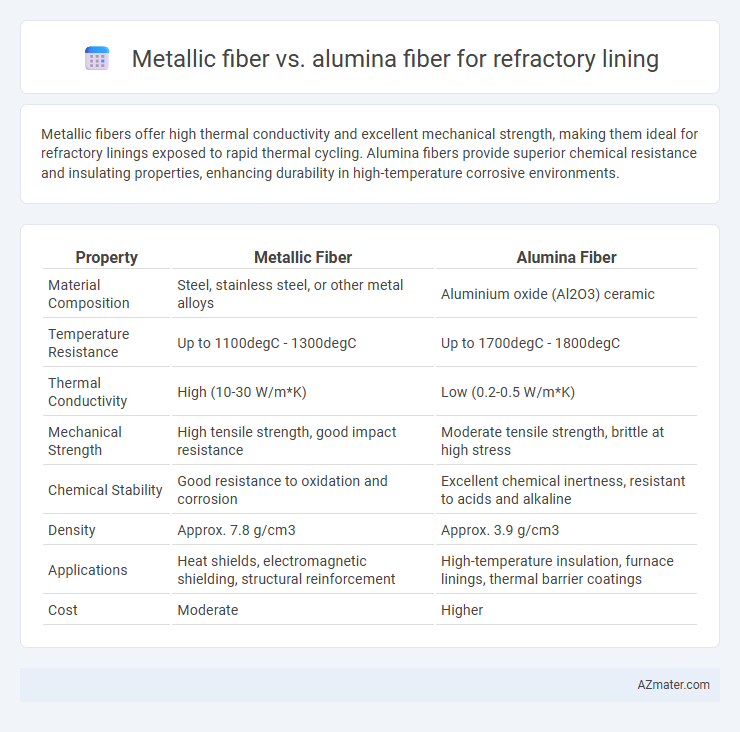Metallic fibers offer high thermal conductivity and excellent mechanical strength, making them ideal for refractory linings exposed to rapid thermal cycling. Alumina fibers provide superior chemical resistance and insulating properties, enhancing durability in high-temperature corrosive environments.
Table of Comparison
| Property | Metallic Fiber | Alumina Fiber |
|---|---|---|
| Material Composition | Steel, stainless steel, or other metal alloys | Aluminium oxide (Al2O3) ceramic |
| Temperature Resistance | Up to 1100degC - 1300degC | Up to 1700degC - 1800degC |
| Thermal Conductivity | High (10-30 W/m*K) | Low (0.2-0.5 W/m*K) |
| Mechanical Strength | High tensile strength, good impact resistance | Moderate tensile strength, brittle at high stress |
| Chemical Stability | Good resistance to oxidation and corrosion | Excellent chemical inertness, resistant to acids and alkaline |
| Density | Approx. 7.8 g/cm3 | Approx. 3.9 g/cm3 |
| Applications | Heat shields, electromagnetic shielding, structural reinforcement | High-temperature insulation, furnace linings, thermal barrier coatings |
| Cost | Moderate | Higher |
Introduction to Refractory Lining Materials
Refractory lining materials, essential for high-temperature industrial furnaces, include metallic fibers and alumina fibers, each offering unique thermal and mechanical properties. Metallic fibers provide excellent thermal conductivity and mechanical strength, enhancing durability under cyclic thermal shock. Alumina fibers excel in chemical resistance and insulation, maintaining structural integrity in highly corrosive environments and extreme temperatures.
Overview of Metallic Fibers
Metallic fibers used in refractory linings offer exceptional thermal conductivity, mechanical strength, and resistance to thermal shock, making them ideal for high-temperature industrial applications. These fibers, typically composed of stainless steel or other alloys, enhance structural integrity and improve heat dissipation compared to alumina fibers, which primarily provide thermal insulation due to their ceramic nature. The integration of metallic fibers in refractory materials significantly increases durability and lifespan under extreme furnace or kiln operating conditions.
Overview of Alumina Fibers
Alumina fibers, composed primarily of aluminum oxide (Al2O3), exhibit exceptional thermal stability and resistance to chemical corrosion, making them ideal for refractory linings in high-temperature industrial applications. These fibers provide superior insulation properties, low thermal conductivity, and excellent mechanical strength, which enhance the durability and energy efficiency of refractory linings compared to metallic fibers. Alumina fibers also offer excellent resistance to thermal shock and oxidation, ensuring longer service life under extreme thermal cycling conditions.
Key Properties Comparison: Metallic vs Alumina Fibers
Metallic fibers exhibit superior thermal conductivity and mechanical strength, enabling enhanced durability and heat dissipation in refractory linings compared to alumina fibers. Alumina fibers provide excellent thermal insulation, higher melting points, and better resistance to chemical corrosion, making them ideal for high-temperature stability and oxidative environments. The choice between metallic and alumina fibers depends on the specific application requirements for thermal management, mechanical resilience, and environmental exposure in refractory systems.
Thermal Conductivity and Insulation Performance
Metallic fibers in refractory linings exhibit higher thermal conductivity, typically ranging from 15 to 50 W/m*K, which enhances heat dissipation but reduces insulation efficiency compared to alumina fibers. Alumina fibers, with low thermal conductivity values around 0.03 to 0.2 W/m*K, provide superior insulation performance due to their excellent resistance to heat transfer and thermal shock. The choice between metallic and alumina fibers depends on the required balance between thermal insulation and heat conduction in high-temperature industrial applications.
Mechanical Strength and Durability
Metallic fibers exhibit superior mechanical strength compared to alumina fibers, making them ideal for refractory linings exposed to heavy mechanical stress and abrasion. Alumina fibers offer high-temperature stability and excellent chemical resistance, but their brittleness reduces durability under repeated thermal cycling and mechanical impact. For applications demanding enhanced toughness and long-term durability, metallic fibers provide a more resilient refractory lining solution.
Chemical Resistance and Corrosion Behavior
Metallic fibers in refractory linings offer superior mechanical strength but are more susceptible to chemical attack and corrosion, especially in acidic or molten metal environments, compared to alumina fibers. Alumina fibers exhibit exceptional chemical resistance and corrosion behavior due to their stable oxide composition and high melting point, making them ideal for aggressive, high-temperature applications. Selecting alumina fibers enhances refractory longevity where chemical inertness and corrosion resistance are critical performance factors.
Installation and Maintenance Considerations
Metallic fibers offer enhanced durability and flexibility during refractory lining installation, allowing for quicker adaptation to structural shapes and reducing labor time compared to alumina fibers. Alumina fibers, while providing excellent thermal resistance, often require more careful handling and prolonged maintenance due to their brittleness and susceptibility to damage during installation. Maintenance of metallic fiber linings is generally less intensive, benefiting from their resistance to corrosion and mechanical stress, whereas alumina fiber linings may necessitate frequent inspections and repairs to maintain structural integrity under high thermal cycling.
Cost Analysis and Long-Term Value
Metallic fiber refractory linings typically incur higher initial costs compared to alumina fiber linings due to complex manufacturing and raw material expenses. Alumina fiber offers lower upfront investment and good thermal insulation but may require more frequent replacement, increasing lifecycle maintenance costs. Long-term value favors metallic fiber for applications demanding superior durability and mechanical strength, resulting in reduced downtime and replacement frequency despite the higher initial outlay.
Application Suitability: Choosing the Right Fiber
Metallic fibers exhibit excellent thermal conductivity and mechanical strength, making them ideal for high-temperature furnace linings and applications requiring rapid heat dissipation. Alumina fibers provide superior thermal insulation, chemical resistance, and stability at temperatures exceeding 1000degC, perfect for chemical reactors and kiln linings. Selecting between metallic and alumina fibers depends on whether heat conduction or insulation is the priority, alongside factors like operating temperature and environment corrosion.

Infographic: Metallic fiber vs Alumina fiber for Refractory lining
 azmater.com
azmater.com